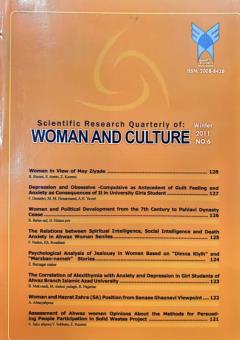The Correlation of Alexithymia with Anxiety and Depression in Girl Students of Ahwaz Branch Islamic Azad University
Subject Areas : Psychologyبهنام Makvandi 1 , منیژه Shehni Yailagh 2 , بهمن Najarian 3
1 - Ph.D students of Department of Psychology, Science and Research Branch, Islamic Azad University, Khouzestan, Ahwaz, Iran
2 - Professor of Department of psychology, Shahid Chamran University.
3 - Professor in Department of Psychology, Science and Research Branch, Islamic Azad University, Khouzestan, Ahwaz, Iran
Keywords:
Abstract :
The purpose of this study was to investigate the correlations of alexithymia with anxiety and depression in girl students of Ahvaz Branch Islamic Azad University. 185 female students were selected through stratified random sampling. Instruments were Ahwaz Alexithymia Scale (AAS – 26), Beck Anxiety Inventory (BAI) and Beck Depression Inventory (BDI). Present research was a correlation type and the results indicated that alexithmia had positive correlation with and anyiety and depression. Finally a multiple regression analysis showed that anxiety and depression had multiple correlations with alexithymia. The results also revealed that anxiety and depression were significant predictors of alexithymia.
احدی، بتول. (1388). نقش ویژگی های شخصیتی ناگویی خلقی در پیش بینی نشانه های آسیب شناسی روانی در بیماران مبتلا به افسردگی اساسی. تحقیقات علوم رفتاری،دوره 7، شماره 1، 32-25.
ساعتچی، محمود.، کامکاری. و کامبیز، عسگریان، مهناز. (1389). آزمونهای روانشناختی: تهران: انتشارات نشر ویرایش.
رجبی، غلامرضا، بهرانی، محمود(1380). تحلیل عاملی سوالهای مقیاس اضطراب مرگ(BAF)، مجله روانشناسی بیست، سال پنجم، شمارۀ چهارم، 344-331.
عسکری، پرویز. (1388). راهنمای آزمون های روانشناختی. اهواز: انتشارات دانشگاه آزاد اسلامی اهواز.
فتحی آشتیانی، علی. (1388). آزمون های روانشناختی. تهران: انتشارات بعثت.
مظاهری، مینا.، افشار، حمید.، محمدی، نرگس.، دقاق زاده، حامد.، باقریان، رضا. و ادیبی، پیمان (1389). ارتباط ابعاد الکسی تایمیا با افسردگی و اضطراب در مبتلایان به اختلالات گرایشی عملکردی تحقیقات علوم رفتاری، دوره 8، شماره2، 102-92.
Aleman, A, kahn, RS, & Selten, Jp. (2003). Sex differences in the risk of schizophrenia – evidence from mata – analysis Arch Gen psychiatry; 60: 565 – 71.
Berthoz, S. Consoli, S, Perez – Diaz, F, & Jouvent, R. (1999). Alexithymia and anxiety: Compounded relationships? A psychometric study. Eur Psychiatry; 14 (7): 372-8.
Carver, CS. & Miller, CJ. (2006). Relations of serotonin function to personality: current views and a key methodological issue Psychiatry Res; 144 (1): 1-15.
Haviland, MG, Shoaw, DG, Cummings, MA, & Mac Murray, JP. (1988). Alexithymia: subscales and relationship todepression. Psychother Psychosom; 50 (3): 164-70.
Jones, MP, Schettler, A. Olden, K, & Crowell, MD. (2004). Alexithymia and soma to sensory amplification in functional dyspepsia. Psychosomatics; 45(6): 508-16.
Luminet, O. (2006). Alexithymia and level of processing: evidence for an overall deficit in remembering emotional word. J Res Personal; 40: 713-733.
Luminet, O, Bagby, RM, & Taylor, GJ. (2001). An evaluation of the absolute and relative stability of alexithymia in patients with major depression. Psychaother psychosom; 70(5): 254 – 60.
Motan I, & Gencoz, T. (2007). The relationship between the dimensions of alexithymia and the intensity of depression and anxiety. Turk Psikiyatri Dery; 18 (4): 333-43.
Parker , DA, Taylor, G, & Bagby, RM. (2001). The relationship between emotional intelligence and alexithymia. Pers Individ Differ; 30: 107 – 115.
Saarijarvi, S, Salmicnen, jk, & Toikka, TB. (2001). Alexithymia and depression: a 1-year follow – up study in out patients with major depression. J Psychosom Res; 51(6): 729 – 33.
Saarijarvi, S, Salminen JK, & Toikka, T.B (2006). Temporal stability of alexithmia over a five – year period in outpatients with major depression. Psychother psychosom; 75(2): 107-12.
Salminen, JK, Saarijarvi, S, Aarela, E, Toikka, T, & Kauhanen, J. (1999) Prevalence of alexithmia and its association with sociodemographi variables in the general population of finlaud. Psychosom Res; 46- 75-82.
Sayar, k.Solmaz, M, Trablus, S, Ozturk, M, & Acar, B. (2000). Alexithymia in Irritable Bowel syndrome Turkish Journal of Psychiatry; 11(3): 190-7.
Sifneos, PE. (1973). The prevalence of alexithymic characteristics in psychososmatic patients. Psychothera Psychosom; 22: 255-62.
Sifneos, PE, Apfel – Savit, R. , & Frankel, FH. (1977). The phenomenon of alexithymia. Observations in neurotic and psychosomatic patients. Psych other Psychosom; 28: 47 – 57.
Taylor, GJ. & (2000). Recent developments in alextiymia theory and research. Can psychiatr; 45: 134 – 142.
Taylor, GJ, Bagby, M. (2000). An overview of the alexithymia construct. In Bar- on R, Parker JDA (eds). The handbook of emotional intelligence. San Francissco: jossey – Bass: 263 – 276.
Taylor, GJ. & Bagby, RM. (2004). New trands in alexithmia research psychother psychosom; 73(2): 68-77.
Taylor, GJ, Baby, RM. Parker, JD, & Grotstein, J. (1999). Disorder of affect regulation: alexithmia in medical and psychiatric illness. ed. Com bridge: University Press.
Vorst, HCM, & Bermond, B. (2001). Validity and ralibility of the Bermond – vorst Alexithymia questionnaire. Pers Individ Differ; 30: 413-34.
Wise, TN, Mann, Ls, & Hill, B. (1990). Alexithymia and depressed mood in the psychiatric patient. Psych other Psychosom; 54(1): 26-31
_||_

